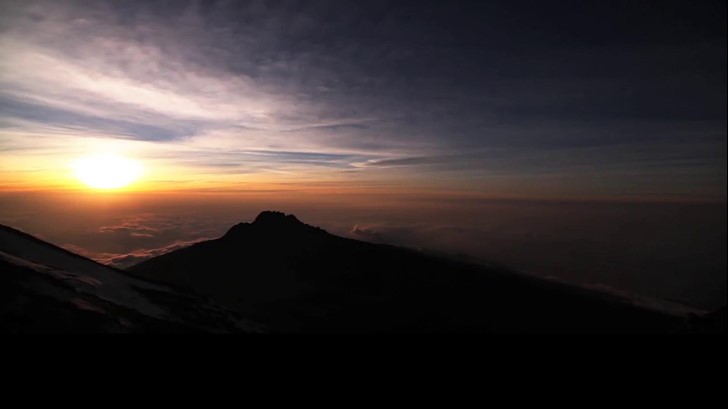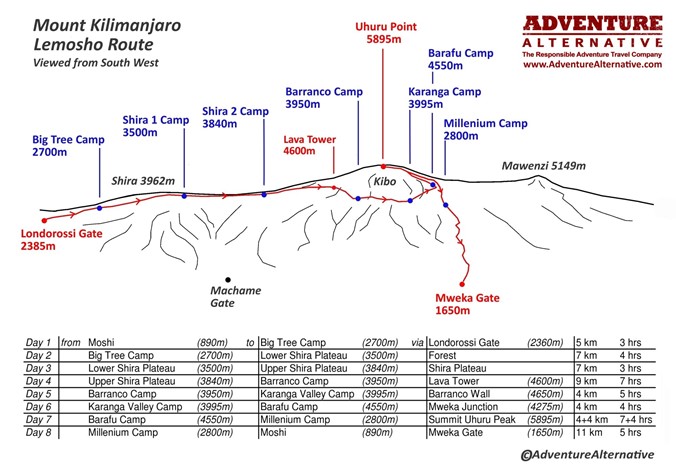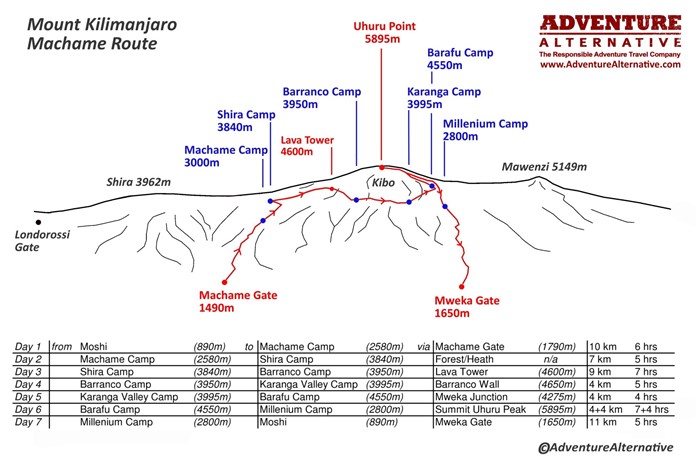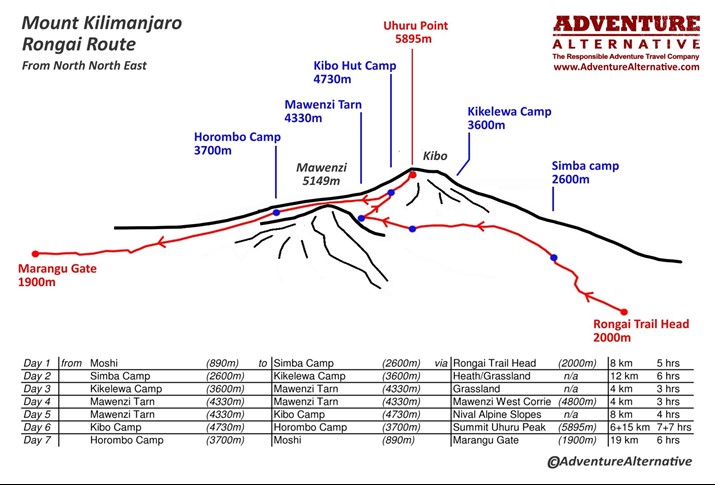| Quick Links | ||||||||
|---|---|---|---|---|---|---|---|---|
| Trips | About | Charity Climb | Facts | Required Fitness |
FAQ | Why Climb With Us |
Camps | Books & Maps |
Kilimanjaro Routes
The Kilimanjaro Experience
Dominating the landscape like no other mountain, iconic and instantly recognisable, Kilimanjaro in Tanzania is the highest peak in Africa and the world's tallest freestanding mountain at 5895 metres. To climb Kilimanjaro is a great challenge and entirely feasible for the active traveller or keen walker looking for something new. In a matter of days you’ll climb Kilimanjaro from the hot plains of Africa through grasslands, tropical rain forest, alpine meadows, moorlands and desert uplands onto snow and ice.
As one of the premier Mount Kilimanjaro tour operators, we have regular climbs on four of the main routes:
- Trekking Mount Kilimanjaro via the Machame route in 7 days is our preferred route as it offers excellent acclimatisation and views.
- The Lemosho route, is the same as the Machame route after the second camp (Shira Plateau), but gives an extra day on the mountain.
- Or there is the Rongai route, which approaches from the north of the mountain and is a less travelled option. It's also good during the rainy season as it's more sheltered.
- Or for those who have a bit of time we also have climbs via the 9 day Northern Circuit route.
We also organise lots of climbs for charities, walking clubs and groups too. Contact us for your Private Kilimanjaro Trek or join one of the open trips to meet like minded individuals. On the route pages below you will find alongside itineraries, altitude profiles, kit lists and pictures, as well as a host of information pages to help you decide and prepare. Call the office and chat to people who have been up the mountain many times and can offer proper advice.
Kilimanjaro Route Map

Click the image above to explore Kilimanjaro in Google Earth
Experienced Kilimanjaro Tour Operator
We’re a company run by mountaineers so you’ll find safe itineraries, safety measures and training for all our staff. Our office crew are outdoors people with a wealth of experience on Kilimanjaro, and they also remember what it’s like to dream of a climb to the roof of Africa! They can answer your questions and help put the whole trip into perspective. So don’t be afraid to call us for a chat or drop us an email with any questions.
We've been running trips to Kilimanjaro since 1991 when company founder Gavin was living in Nairobi and guiding on this mountain and Mount Kenya, and using the proceeds to fund his fledgling charity Moving Mountains. After some time he employed his friend and local guide Castro to start our own company in Moshi called Adventure Alternative Tanzania and three decades later we still work together.
Our local guides are really lovely people who are qualified and very experienced. For many years we've been taking groups from all over the world up Kilimanjaro, including Irish and UK walking clubs, schools and universities and even record breakers to the summit. We have to date had five clients propose to their loved one on reaching the summit, taken the youngest British person to the summit and our Kilimanjaro acclimatisation programme has given us an average 95% success rate to reach the highest point in Africa.
Facts about Kilimanjaro
Kilimanjaro translates to “mountain of the springs” and its unique position just below the equator offers an opportunity to experience five different habitats from bottom to top, which makes an ascent of the mountain undeniably special. In a matter of days you’ll climb Kilimanjaro from the equator to what feels like the Arctic, moving through grasslands, tropical rainforest, alpine meadows, moorlands and desert uplands to snow and ice.
One of the most commonly asked questions we get is What to Wear on Kilimanjaro? It's really important that you look at our Kilimanjaro Kit List but be assured that you don't need to spend a fortune on kit when you can rent sleeping bags, trekking poles and many other items from us. In the more information section on this site you will also find details on Kilimanjaro Trip Preparation.
Fitness and Altitude Sickness on Kilimanjaro
No doubt the trek is challenging and you are going to extreme altitude, however, the pace is slow due to going to altitude, which often surprises people, but it's essential for a safe and successful ascent. We have a page on training for Kilimanjaro but generally we would recommend practising by hiking on the hills with a backpack on for at least several months prior to the trip.
When you start to look at altitude and altitude sickness and what it can do to your body, people do get concerned, however our policy of taking a minimum of seven days allows you to acclimatise well. There are also info pages about health and altitudes effects on your body and acclimatising safely, plus details about whether you should use the altitude drug Diamox on Kilimanjaro.

Sunrise on summit day looking down from the edge of the main crater rim, to the lower summit of Mawenzi Peak
Best time to Climb Kilimanjaro?
The main seasons are traditionally December to March and June to October with temperatures in Moshi averaging 22 degrees C and summit temperatures around - 7 degrees C. The rains are in April, May and November but nowadays climate change has changed this pattern so sometimes the rains come earlier or later. During the rains we run our Rongai climbs as the northern side of the mountain is more sheltered.
A full moon climb of Kilimanjaro, or indeed a new moon climb, is often a popular time to climb. Summit night can be spent walking under the light of a full silvery moon so that you don't even need a headtorch; or, since Kilimanjaro is situated on the equator, under a full sky of both north and south constellations. In fact from high up on the peak you can see the North Star and the Southern Cross in the same sky. If you want to avoid the busier nights on a full moon then we recommend that you offset your summit night. There can be no doubt that on certain nights the summit route can be very busy with a lot of people leaving camp at the same time and initially creating a bottleneck. These groups spread out fairly quickly though.
| Month | 2022 New Moon | 2022 Full Moon | 2023 New Moon | 2023 Full Moon |
|---|---|---|---|---|
| Jan | 2 | 17 | 21 | 6 |
| Feb | 1 | 16 | 20 | 5 |
| March | 2 | 18 | 21 | 7 |
| April | 1 & 30th | 16 | 19 | 5 |
| May | 30 | 16 | 19 | 5 |
| June | 29 | 14 | 17 | 3 |
| July | 28 | 13 | 17 | 3 |
| Aug | 27 | 12 | 16 | 1 & 30 |
| Sept | 26 | 10 | 14 | 29 |
| Oct | 25 | 9 | 14 | 28 |
| Nov | 24 | 8 | 13 | 27 |
| Dec | 23 | 7 | 12 | 26 |
Other notable dates:
Valentines Day Summit: Arrive Tanzania on the 7th Feb
New Years Eve / Day Summit: Arrive Tanzania on the 25th Dec
Check out our more detailed guide on the best time to climb Mount Kilimanjaro here.
Frequently Asked Questions
How Long Does It Take To Climb Kilimanjaro?
We have a policy never to run trips less than seven days because it's too dangerous to try and go to nearly 6000 metres in any less time. Of course, probability will always dictate that some people do, but on the whole those people suffer more and are putting their health at risk from potential altitude sickness. It's better and far more fun to take a minimum seven days and enjoy the experience. Some trips are eight days which is even better.
But to climb Kilimanjaro is expensive nowadays, the cost per day for a permit is over USD$100.00 so there is an incentive to try and climb the mountain faster. Given the time you could acclimatise on Mount Meru or even Mount Kenya first, but the majority arrive into Moshi airport and go straight up Kilimanjaro. All of the major guiding organisations like the UIAA recommend no less than seven days. Over several decades our experience shows that the success rate is about 95% for a seven day trip.
If you add in a rest day at the beginning and travel days then the time to climb Kilimanjaro is ten days. Most people opt for a a short four day safari to Ngorongoro Crater and two other parks in order to end up with a two week holiday which can be spread over two weekends.
What is the Weather like on Kilimanjaro?
Expect warm early days to be 18 - 20 degrees Celsius, cooler days up higher around 14 degrees C and summit day to be as cold as minus 5 with a windchill of minus 15 degrees C. The mountain doesn't experience a wide temperature range from season to season, so it's much the same throughout the year. However, temperatures are determined by the altitude and the time of the day.
It can be wet and cold, hot and dry and sunny all in one day, and don't forget the intensity of the sun at altitude means it's important to protect your skin and eyes. The rainforest ( also known as cloud forest or montane at this altitude) around the base is warm and humid, the moorland and alpine desert is drier and cooler, while the arctic zone is of course very cold with snow and strong winds.
High mountains create their own micro-climates, which are areas in which the climate differs from the prevailing - or main - climate. On Kilimanjaro this is a common feature; it has several micro-climates from hot at the bottom to freezing arctic at the summit. The flow of air masses over Kilimanjaro influences these micro-climates which causes wet (or snowy) weather on one side and a dry, clear climate on the other. Machame is on the wetter side, while Rongai is on the drier side.
How much does it cost to climb Kilimanjaro?
A full breakdown of Kilimanjaro trip inclusions and exclusions is on each route page but as an average the Machame route cost is around 1895.00 GBP for a fully guided trip. Other routes are a little more expensive because the transport to the gate is farther away.
Additionally you will need a flight to Kilimanjaro airport near Arusha in Tanzania, a visa which you can buy on arrival, travel insurance, and personal expenses like meals in Moshi, kit rental and tips.
You need to bring your own personal clothing and sleeping bag but we have a store with most items for rent. Sleeping bags, poles, waterproofs, flasks, duffle bags and so on are all available.
Tips generally come to 80.00GBP per visitor and this is given in local currency to Castro at the end of the climb.
In total a climb of Kilimanjaro will cost around 2650.00GBP.
How hard is it to climb Mount Kilimanjaro?
The terrain on Kilimanjaro varies during a period of seven or eight days and the days vary in terms of hardness. You are traversing the mountain over about 38 miles, ascending from 2000m to 5895m and back down, passing through cultivated farmland, equatorial forest and alpine heath, across a lunar-like volcanic desert and up to a glaciated summit. It is not a technical climb and there are no precipitous drops along the way, no rock climbing or specialist equipment needed, but it is high! And the weather and temperature variance will make it tiring on your body.
The paths are in good condition and well trodden; some are steeper than others (in particular the Great Barranco Wall is an exciting scramble) but obviously they all get harder as you go higher. You will pant more easily, your muscles will feel more tired having had to work in an atmosphere with less oxygen, you will need more calories for the energy needed and a combination of the hot sun (and strong UV) and cold nights will drain you too. The trick is to eat well, drink lots, sleep well and go slowly. It sounds easy but people lose their appetite, forget to drink 3 litres a day, find they don't sleep so deeply at altitude and often race ahead. A guide's job is most commonly advising people continually on these four main tenets in order to give yourself the best chance of getting up and down safely.
On summit day the path is mostly scree and loose rock and dust and patches of ice and snow. In the early hours of the night the ground is hard so it's quite easy, which is one of the reasons we climb at night, but as the sun comes up the terrain becomes loose and slippery, especially on the descent when your knees will probably suffer. Summit night is a long night, leaving at midnight to climb nearly 1300 metres to the top for dawn, and then all the way back down to the forest line in one day. Most people are really exhausted, but also elated by the experience and the magnitude of the challenge. If you have ascended in the cold and wind and snow then there's no doubting that it's a big challenging day. And at just under 6000 metres it is similar to the height of camp 1 on Mount Everest.
What experience do I need for Mount Kilimanjaro?
Kilimanjaro is non-technical but it does offer a full mountaineering experience. Experience in hill walking is a benefit but not absolutely necessary, since this is a supported climb. You will have however be outdoors constantly and living in tents so any sort of experience with camping will be useful and a good level of training is expected, especially on the thigh and calf muscles.
It is not necessary to have any experience of high altitude to climb Kilimanjaro, and there is nowhere in the United Kingdom or Ireland to possibly train for it. The important factor will be to go slowly and allow your metabolism to adapt to the lower air pressure and the thinner air, and be aware of altitude health at all times.
For most people the key moments on this trip are those hours on summit night in the dark when the hours seem to stretch ahead of you and the giant black bulk of the mountain never seems to get any smaller. This is really where character and teamwork come into play, and in this respect experience can take a back seat to just the fundamental will power and collective spirit to summit. Many people find this process quite transformative, it is inevitably a very personal experience to dig deep within yourself at over 5000 metres and push onwards and upwards. These are moments in Life which are life changing.
What support will you get on Mount Kilimanjaro?
The staff will carry your main bag plus all the tents, kitchen equipment, food, fuel, tables and chairs. They will cater for all the group needs, providing excellent meals and putting up the tents. The guides will also brief you daily on the climb and they will assist you all the way to the summit and back down again. They have been working for us since 2001 and are fully trained and very experienced.
Castro Capelo is our operations manager in Moshi and Director of Adventure Alternative Tanzania. He organises all the staff, equipment, permits and hotel arrangements. He is the main link between you and the UK office. He talks to the guides every day on the mountain and can make arrangements while you are up high. You also have continued support from the main office in Northern Ireland. Should a problem arise of significant proportion then you only need to call us.
Why choose us as your Kilimanjaro Tour Operator?
We're now in third decade guiding on Kilimanjaro and run our own company in Tanzania which is based in Moshi at the foot of Kilimanjaro called Adventure Alternative Tanzania and our dedicated team provide an excellent service.
- We are a mountain company run by mountaineers, established since 2001
- We take safety on Kilimanjaro seriously and our staff are trained to deal properly with emergencies
- We have a 95% success rate to the summit because of a seven day minimum policy which assists proper acclimatisation
- All our guides are personally trained by Gavin Bate, company director and IML with over twenty years of experience guiding trips to the Greater Ranges. He has guided Kilimanjaro 59 times and still counting.
- We do not outsource our trips, we invest in our staff directly.
- All the staff in our UK office have climbed Kilimanjaro so you can chat to people who understand what it is like to go up for the first time, before you go. We spend time on the phone and we are happy to make personal visits to meet groups or individuals where possible. We provide all the Kilimanjaro facts, under the gloss!
- We are passionate about responsible tourism and our company supports sustainable development in Tanzania and Kenya in a real way. We have won the World Responsible Tourism Awards twice now.
- Our guides carry oxygen bottles and masks, a portable stretcher, altitude first aid a mountain shelter on every trip and they are qualified to UK outdoor first aid certification.
- We provide in depth information during the trip on altitude acclimatisation, diet, descent procedures and using altitude drugs. These documents are put on the table every day for common use.
Kilimanjaro Camps
Lemosho Route Camps

View our Lemosho Route trek here.
Machame Route Camps

View our Machame Route trek here.
Rongai Route Camps

View our Rongai Route trek here.
Kilimanjaro Books and Maps
Kilimanjaro Region Guides
| Kilimanjaro Trekker's Guide, Cicerone | ISBN-10: 1852844132, ISBN-13: 978-1852844134 |
| Kilimanjaro, Trailblazer Publications | ISBN-10: 1905864248, ISBN-13: 978-1905864249 |
| Kilimanjaro & East Africa: A Climbing and Trekking Guide | ISBN-10: 0898866049, ISBN-13: 978-0898866049 |
| Kilimanjaro & East Africa: Climbing & Trekking Guide | ISBN-10: 190420743X, ISBN-13: 978-1904207436 |
| Trekking in East Africa, Lonely Planet | ISBN-10: 1864502894, ISBN-13: 978-1864502893 |
| The Rough Guide to Tanzania | ISBN-10: 1848360754, ISBN-13: 978-1848360754 |
| Tanzania, Lonely Planet | ISBN-10: 174104555X, ISBN-13: 978-1741045550 |
| The Shadow of Kilimanjaro, Ridgeway, Bloomsbury | ISBN-10: 074758575X, ISBN-13: 978-0747585756 |
| The Snows Of Kilimanjaro, Hemingway, Vintage Classics | ISBN-10: 0099460920, ISBN-13: 978-0099460923 |
| Seven Summits, Bass, Gramercy Books | ISBN-10: 0517227509, ISBN-13: 978-0517227503 |
Maps
| Kilimanjaro, 1:62,500, ITMB Publishing | ISBN-10: 1553415507, ISBN-13: 978-1553415503 |
| Kilimanjaro: Map and Guide, 1:75,000/1:30,000 | ISBN: 0906227666 |
| Kilimanjaro, 1:80,000, Climbing Map | ISBN 13: 9783952329412 |
| Kilimanjaro National Park, 1:125,000 | Maco Editions |


